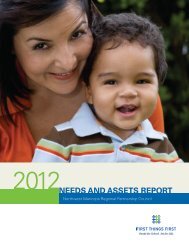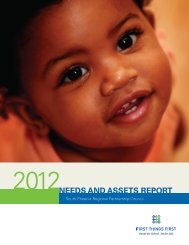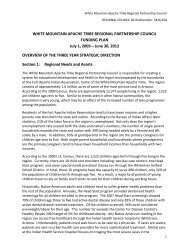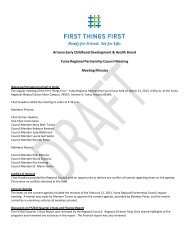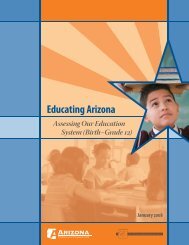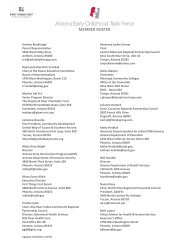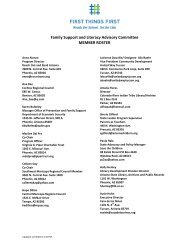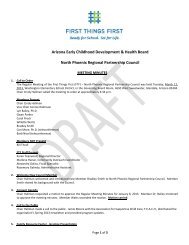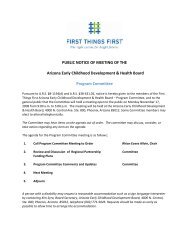Parents as Teachers
Parents as Teachers
Parents as Teachers
Create successful ePaper yourself
Turn your PDF publications into a flip-book with our unique Google optimized e-Paper software.
87% of Native American children served by <strong>Parents</strong> <strong>as</strong> <strong>Teachers</strong> through its Baby FACE program were ready forpreschool by age 3. v<strong>Parents</strong> <strong>as</strong> <strong>Teachers</strong> children scored significantly higher on m<strong>as</strong>tery motivation at 36 months. At 24 months,greater effects were found for low-income <strong>Parents</strong> <strong>as</strong> <strong>Teachers</strong> families whose children scored significantly higheron cognitive development and m<strong>as</strong>tery motivation than comparison group families. vi<strong>Parents</strong> <strong>as</strong> <strong>Teachers</strong> Supports Later School Achievement The aforementioned 2007 study of 7,710 Missouri public school children also showed that length of participationin PAT w<strong>as</strong> a significant predictor of children’s third grade achievement on the Missouri Assessment ProgramCommunication Arts test. viiPAT children scored significantly higher on standardized me<strong>as</strong>ures of reading and math at the end of first gradethan did comparison children. In addition, teachers rated PAT children’s achievement progress higher than controlgroup children’s progress in all are<strong>as</strong>. viiiPAT children continued to perform better than non-PAT children on standardized tests of reading and mathachievement in second grade. Compared to non-PAT children, PAT children required half the rate of remedial andspecial education placements in third grade. ix<strong>Parents</strong> <strong>as</strong> <strong>Teachers</strong> Prevents Child Abuse The U.S. Advisory Board on Child Abuse and Neglect states, “home visiting and center-b<strong>as</strong>ed programs with aparental focus can help prevent child abuse and neglect.” x The T<strong>as</strong>k Force on Community Preventive Servicesrecommends early childhood home visitation <strong>as</strong> an effective method for preventing child abuse and neglect. xiIn a randomized trial, adolescent mothers who received c<strong>as</strong>e management and <strong>Parents</strong> <strong>as</strong> <strong>Teachers</strong> weresignificantly less likely to be subjected to child abuse investigations than control group mothers who receivedneither c<strong>as</strong>e management nor <strong>Parents</strong> <strong>as</strong> <strong>Teachers</strong>. xiiIn another randomized trial, adolescent mothers in an urban community who participated in <strong>Parents</strong> <strong>as</strong> <strong>Teachers</strong>scored lower on a child maltreatment precursor scale than mothers in the control group. These adolescentmothers showed greater improvement in knowledge of discipline, showed more positive involvement withchildren, and organized their home environment in a way more conducive to child development. xiii<strong>Parents</strong> <strong>as</strong> <strong>Teachers</strong> families had fewer documented c<strong>as</strong>es of abuse and neglect in comparison to the Missouristate average. xiv<strong>Parents</strong> <strong>as</strong> <strong>Teachers</strong> Incre<strong>as</strong>es Parental Involvement Results of a multi-site randomized trial showed that for families with very low income, those who participated in<strong>Parents</strong> <strong>as</strong> <strong>Teachers</strong> were more likely to read aloud to their child and to tell stories, say nursery rhymes, and singwith their child. xvA significantly higher proportion of <strong>Parents</strong> <strong>as</strong> <strong>Teachers</strong> parents initiated contacts with teachers and took anactive role in their child’s schooling. For example, 63% of parents of <strong>Parents</strong> <strong>as</strong> <strong>Teachers</strong> children versus 37% ofparents of comparison children requested parent-teacher conferences. xvi<strong>Parents</strong> <strong>as</strong> <strong>Teachers</strong> parents demonstrated high levels of school involvement, which they frequently initiated, andsupported their children’s learning in the home. xvii<strong>Parents</strong> <strong>as</strong> <strong>Teachers</strong> parents read more to their children, use more techniques to support book/print concepts,and have more children’s books in the home. xviii<strong>Parents</strong> <strong>as</strong> <strong>Teachers</strong> Improves Children’s Health and Development Outcomes Annual health and developmental screenings is a core component of <strong>Parents</strong> <strong>as</strong> <strong>Teachers</strong>. Of the 200,000 pluschildren screened in the most recent program year, 13% were identified with possible health/developmentaldelays and were referred on for additional follow up services. 70% of those referred received follow-up services. xixChildren participating in <strong>Parents</strong> <strong>as</strong> <strong>Teachers</strong> were much more likely to be fully immunized for their given age, andwere less likely to be treated for an injury in the previous year. xxAt age 3, <strong>Parents</strong> <strong>as</strong> <strong>Teachers</strong> children performed significantly above national norms on a me<strong>as</strong>ure of schoolrelatedachievement, despite the fact that the sample w<strong>as</strong> over-represented on all traditional characteristics ofrisk. More than one-half of the children with observed developmental delays overcame these delays by age 3. xxi8/10<strong>Parents</strong> <strong>as</strong> <strong>Teachers</strong>2228 Ball Drive – St. Louis, MO 631461-866-PAT4YOUwww.<strong>Parents</strong>As<strong>Teachers</strong>.org2
i Pfannenstiel, J.C. & Zigler, E. (2007). Prekindergarten experiences, school readiness and early elementary achievement. Unpublished report preparedfor <strong>Parents</strong> <strong>as</strong> <strong>Teachers</strong> National Center.iiZigler, E., Pfannenstiel, J.C., & Seitz, V. (2008). The <strong>Parents</strong> <strong>as</strong> <strong>Teachers</strong> Program and School Success: A Replication and Extension. Journal ofPrimary Prevention, 29, 103-120.iiiDrazen, S., & Haust, M. (1995). The effects of the <strong>Parents</strong> and Children Together (PACT) program on school achievement. Binghamton, NY.; Drazen,S. & Haust, M. (1996). L<strong>as</strong>ting academic gains from an early home visitation program. Paper presented at the annual meeting of the AmericanPsychological Association, August 1996.ivPfannenstiel, J. C., Seitz, V., & Zigler, E. (2002). Promoting school readiness: The role of the <strong>Parents</strong> <strong>as</strong> <strong>Teachers</strong> program. NHSA Dialog: AResearch-to-Practice Journal for the Early Intervention Field, 6, 71-86.v Research and Training Associates, Inc. (2006). BIA Baby Family and Child Education Program: 2005 Report. Executive Summary.vi Drotar, D., Robinson, J., Jeavons, I., and Kirchner, H.L. (2009). A randomized, controlled evaluation of early intervention: The Born to Learncurriculum. Child: Care, health and development, 35, 643-649.viiZigler, E. & Pfannenstiel, J.C., (2007).viiiPfannenstiel, J. (1989). New <strong>Parents</strong> <strong>as</strong> <strong>Teachers</strong> project: A follow-up investigation. Overland Park, KS: Research & Training Associates.ixDrazen, S., & Haust, M. (1995).xPanel on Research on Child Abuse and Neglect (1993), p. 169.xiHahn, R.A., Bilukha, O.O., Crosby, A., Fullilove, M.T., Liberman, A., Moscicki, E.K., et al. (2003). First reports evaluating the effectiveness of strategiesfor preventing violence: Early childhood home visitation. Center for Dise<strong>as</strong>e Control, Morbidity and Mortality Weekly Report, 52, 109.xiiWagner, M.M. & Clayton, S.L. (1999). The <strong>Parents</strong> <strong>as</strong> <strong>Teachers</strong> Program: Results from Two Demonstrations. The Future of Children: Home Visiting:Recent Program Evaluations, 9(1), 91-115.xiiiWagner, M., Iida, E. & Spiker, D. (2001). The multisite evaluation of the <strong>Parents</strong> <strong>as</strong> <strong>Teachers</strong> home visiting program: Three-year findings from onecommunity. Menlo Park, CA: SRI International.xivPfannenstiel, J., Lambson, T., & Yarnell, V. (1991). Second wave study of the <strong>Parents</strong> <strong>as</strong> <strong>Teachers</strong> program. Overland Park, KS: Research & TrainingAssociates.xvWagner, M. & Spiker, D. (2001). Multisite <strong>Parents</strong> <strong>as</strong> <strong>Teachers</strong> Evaluation: Experience and outcomes for children and families. Menlo Park, CA: SRI,Int’l www.sri.com/policy/cehs/early/pat.htmlxviPfannenstiel, J. (1998). New <strong>Parents</strong> <strong>as</strong> <strong>Teachers</strong> project: A follow-up investigation. Overland Park, KS: Research & Training Associates.xviiPfannenstiel, J., Lambson, T., & Yarnell, V. (1996). The <strong>Parents</strong> <strong>as</strong> <strong>Teachers</strong> program: Longitudinal follow-up to the second wave study. OverlandPark, KS: Research & Training Associates.xviii Research and Training Associates, Inc. (2006); Albritton, S., Klotz, J., & Roberson, T. (2004). The effects of participating in a <strong>Parents</strong> <strong>as</strong> <strong>Teachers</strong>program on parental involvement in the learning process at school and home. E-Journal of Teaching and Learning in Diverse Settings, 1, 188-208.xix2005-2006 <strong>Parents</strong> <strong>as</strong> <strong>Teachers</strong> Annual Program Report.xxWagner, M., Iida, E. & Spiker, D. (2001).xxiPfannenstiel, J., Lambson, T., & Yarnell, V. (1991).8/10<strong>Parents</strong> <strong>as</strong> <strong>Teachers</strong>2228 Ball Drive – St. Louis, MO 631461-866-PAT4YOUwww.<strong>Parents</strong>As<strong>Teachers</strong>.org3



